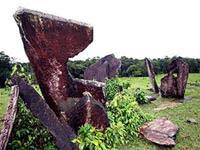 Archaeologists from the Amapá Institute of Scientific and Technological Research (IEPA) in Brazil have discovered an ancient observatory in Calcoene, located approximately 390 km from Macapá, the capital of Amapá state, near the border with French Guiana.
Archaeologists from the Amapá Institute of Scientific and Technological Research (IEPA) in Brazil have discovered an ancient observatory in Calcoene, located approximately 390 km from Macapá, the capital of Amapá state, near the border with French Guiana.
They state that this site dates back around 2,000 years and could only have been constructed by a multicultural society. The observatory is built on 127 granite blocks, each standing 3 meters tall, arranged evenly in circular formations across a wide field.
The site served as an observatory, as the granite blocks were positioned to observe the solstice. In December, sunlight shines through a hole in one of the blocks, allowing for calculations related to agricultural activities and religious rituals. Archaeologists note that the secrets of this observatory are similar to those of the famous Stonehenge in Salisbury, England, where large stones are also arranged systematically, although its purpose remains unclear.
N.T.ĐA


















































